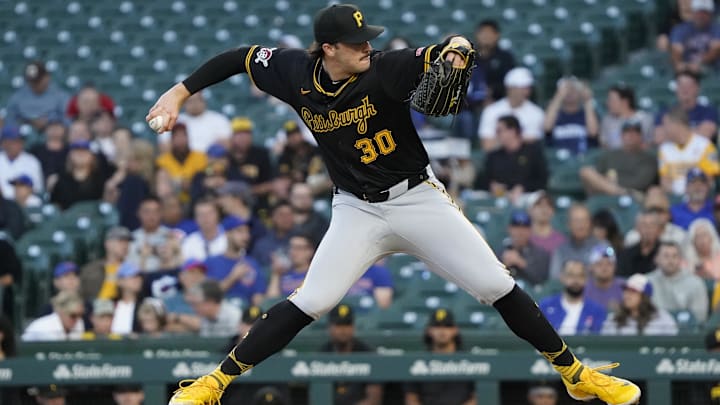Pirates right-hander Paul Skenes just posted one of the greatest rookie seasons by a pitcher in MLB history. He sported a sub-2.00 ERA, struck out nearly a third of the hitters who stepped in the box against him, and went 11-3 on a team that ultimately finished 76-86.
He was so good that it's hard to envision how he could possibly still get better. But at last month's PiratesFest, Skenes laid out some of his personal goals for the 2025 season. While his desire to pitch 240 innings is admirable, though implausible (that feat hasn't been accomplished by any MLB pitcher since 2014 or by a Pirate since 1992), he did say this, which warrants a deeper dive:
"There are a couple things that I've been focusing on this offseason, basically just throwing more strikes, attacking the zone, getting hitters out faster and then just keep learning."Paul Skenes to Pittsburgh Baseball Now
The best way to achieve this, simply put, is by throwing more first-pitch strikes. While that seems obvious (how often is a pitcher ever trying to fall behind early in the count?), Skenes did this with shocking mediocrity in 2024.
Paul Skenes making this adjustment would give the Pirates a luxury they've never had before.
For the purposes of calculating first-pitch strike rate, any strike generated by a pitcher (looking, swinging, or by foul ball), plus balls put in play, are considered strikes. In 2024, Skenes started hitters off with a strike just 62.0% of the time. Out of 108 pitchers who faced 500 or more batters, Skenes ranked 73rd.
Skenes has the stuff and the command to be top-10 in that category. Last year, the top of the list featured some low-walk, pitch-to-contact veterans (Miles Mikolas, Kyle Hendricks) and some top-of-the-rotation arms (Logan Webb, Justin Steele, Shōta Imanaga), as well as both Cy Young Award winners (Chris Sale, Tarik Skubal). If Skenes were his own MLB team, he would have placed 19th, immediately behind the 101-loss Colorado Rockies.
It's tough for a hitter to battle back against any pitcher—much less a pitcher as talented as Skenes—after falling behind in the count. Consider the total league-wide offensive production compared to that of hitters after falling behind 0-1:
Count | BA | OBP | SLG | K% | BB% |
|---|---|---|---|---|---|
any | .243 | .312 | .399 | 22.6% | 8.2% |
after 0-1 | .217 | .263 | .344 | 30.4% | 5.0% |
The splits against Skenes were actually less drastic than this—hitters lost just one point of batting average and 14 points of slugging percentage against him after falling behind 0-1. But more than anything, that's a testament to how tough it is to hit against Skenes in general. He would still benefit greatly from getting ahead in the count more often.
One way Skenes can accomplish this is by diversifying his pitch mix to begin at-bats, as he had a tendency to throw his hard stuff early. Skenes threw either his fastball or his splinker on the first pitch 68.8% of the time, and those were his top two offerings to start at-bats in 17 of his 23 appearances. He shouldn't need to be predictable when there isn't a real weak link in his arsenal—he allowed 10 home runs last year, and half of them were on the first pitch of an AB.
Skenes' reliance on fastballs in 0-0 counts likely stems from his confidence to land them for strikes, which wasn't always the case with his other offerings. But his secondary pitches (curveball, sweeper, slider, changeup) are still plus pitches that can be relied upon early in counts.
While Skenes didn't throw his secondary pitches in the strike zone as often (41.3% versus 54.8% for his fastballs), they are still very difficult pitches to do any kind of damage against. Those four offerings almost exclusively had higher whiff rates compared to his fastballs, and all four had markedly lower average exit velocities. Skenes' stuff is as overpowering as any starting pitcher in the game right now, but his repertoire is so vast that his ability to keep hitters on their toes makes his stuff that much better.
It's about to get even more vast, too. Skenes shared that he's working on introducing a two-seam fastball and a cutter this spring, adding more high-velocity options to his arsenal. Even if his preference or tendency is to throw fastballs early in counts, adding two new variations will still keep hitters guessing, and adding those two pitches specifically should allow him to remain effective against hitters from both sides of the plate.
Skenes was among the most dominant pitchers in the sport last year while setting himself up for success at a below-average rate. Should he figure out how to get ahead of hitters more frequently, he'll continue to get even better. And a better version of Paul Skenes might be the undisputed best pitcher in baseball.
